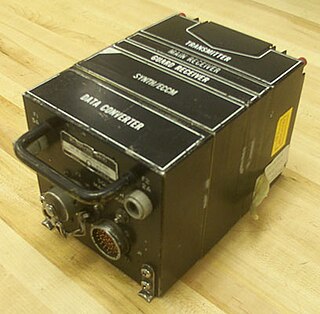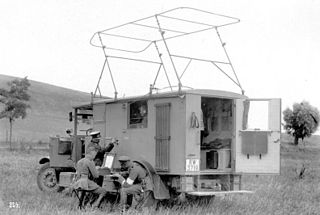Related Research Articles

Frequency allocation is the part of spectrum management dealing with the designation and regulation of the electromagnetic spectrum into frequency bands, normally done by governments in most countries. Because radio propagation does not stop at national boundaries, governments have sought to harmonise the allocation of RF bands and their standardization.
The X band is the designation for a band of frequencies in the microwave radio region of the electromagnetic spectrum. In some cases, such as in communication engineering, the frequency range of the X band is rather indefinitely set at approximately 7.0–11.2 GHz. In radar engineering, the frequency range is specified by the Institute of Electrical and Electronics Engineers (IEEE) as 8.0–12.0 GHz. The X band is used for radar, satellite communication, and wireless computer networks.

HAVE QUICK is an ECM-resistant frequency-hopping system used to protect military aeronautical mobile (OR) radio traffic.
The NATO B band is the obsolete designation given to the radio frequencies from 250 to 500 MHz during the cold war period. Since 1992 frequency allocations, allotment and assignments are in line to NATO Joint Civil/Military Frequency Agreement (NJFA).
The NATO I band is the obsolete designation given to the radio frequencies from 8 000 to 10 000 MHz during the Cold War period. Since 1992 frequency allocations, allotment and assignments are in line to NATO Joint Civil/Military Frequency Agreement (NJFA). However, in order to identify military radio spectrum requirements, e.g. for crises management planning, training, Electromagnetic Warfare (EW) activities, or in military operations, this system is still in use.
The NATO F band is the obsolete designation given to the radio frequencies from 3 000 to 4 000 MHz during the cold war period. Since 1992 frequency allocations, allotment and assignments are in line to NATO Joint Civil/Military Frequency Agreement (NJFA). However, in order to identify military radio spectrum requirements, e.g. for crises management planning, training, Electromagnetic Warfare (EW) activities, or in military operations, this system is still in use.
The NATO M band is the obsolete designation given to the radio frequencies from 60 to 100 GHz during the cold war period. Since 1992 frequency allocations, allotment and assignments are in line to NATO Joint Civil/Military Frequency Agreement (NJFA).

Land mobile service is – in line to ITU Radio Regulations – a mobile service between base stations and land mobile stations, or between land mobile stations.
Every military force has a goal to ensure and have permanent access to radio frequencies to meet its vital military tasks. This is based on strategies, doctrines and different policies that military forces adhere to.

Aeronautical mobile (OR) service is – according to Article 1.34 of the International Telecommunication Union's (ITU) Radio Regulations (RR) – defined as "An aeronautical mobile service intended for communications, including those relating to flight coordination, primarily outside national or international civil air routes".
The NATO L band is the obsolete designation given to the radio frequencies from 40 to 60 GHz during the cold war period. Since 1992 frequency allocations, allotment and assignments are in line to NATO Joint Civil/Military Frequency Agreement (NJFA).
The NATO C-band is the obsolete designation given to the radio frequencies from 500 to 1000 MHz during the cold war period. Since 1992 frequency allocations, allotment and assignments are in line to NATO Joint Civil/Military Frequency Agreement (NJFA). However, in order to identify military radio spectrum requirements, e.g. for crises management planning, training, Electromagnetic Warfare (EW) activities, or in military operations, this system is still in use.
The NATO D band is the obsolete designation given to the radio frequencies from 1.0 to 2.0 GHz during the cold war period. Since 1992 frequency allocations, allotment and assignments are in line to NATO Joint Civil/Military Frequency Agreement (NJFA). However, in order to identify military radio spectrum requirements, e.g. for crises management planning, training, Electromagnetic Warfare (EW) activities, or in military operations, this system is still in use.
The NATO E band is a designation given to the radio frequencies from 2000 to 3 000 MHz during the cold war period. Since 1992 detailed frequency allocations, allotment and assignments are in line to NATO Joint Civil/Military Frequency Agreement (NJFA). However, in order to generically identify military radio spectrum requirements, e.g. for crises management planning, training, Electromagnetic Warfare (EW) activities, radar or in military operations, the Nato band system is often used.
The NATO G band is the obsolete designation given to the radio frequencies from 4 000 to 6 000 MHz during the cold war period. Since 1992 frequency allocations, allotment and assignments are in line to NATO Joint Civil/Military Frequency Agreement (NJFA). However, in order to identify military radio spectrum requirements, e.g. for crises management planning, training, Electronic warfare activities, or in military operations, this system is still in use.
The NATO H band is the obsolete designation given to the radio frequencies from 6 000 to 8 000 MHz during the cold war period. Since 1992 frequency allocations, allotment and assignments are in line to NATO Joint Civil/Military Frequency Agreement (NJFA). However, in order to identify military radio spectrum requirements, e.g. for crises management planning, training, Electronic warfare activities, or in military operations, this system is still in use.
The NATO J band is the designation given to the radio frequencies from 10 to 20 GHz. Since 1992 frequency allocations, allotment and assignments are in line to NATO Joint Civil/Military Frequency Agreement (NJFA). However, in order to identify military radio spectrum requirements, e.g. for crises management planning, training, Electronic warfare activities, or in military operations, this system is still in use.
The NATO K band is the obsolete designation given to the radio frequencies from 20 to 40 GHz during the cold war period. Since 1992 frequency allocations, allotment and assignments are in line to NATO Joint Civil/Military Frequency Agreement (NJFA). However, in order to identify military radio spectrum requirements, e.g. for crises management planning, training, electronic warfare activities, or in military operations, this system is still in use.

NATO Joint Civil/Military Frequency Agreement (NJFA) and is the universal NATO common civil/military treaty to regulate the military access to the radio frequency spectrum in the range of 14 kHz to 100 GHz in peacetime, during exercises, in times of crisis, and in military operations. This document has been the basis for the frequency utilisation in NATO-Europe since 1982. Nations and organisations, e.g. partnership for peace countries, are invited to participate as deemed to be necessary.
The NATO N band is the designation given to the radio frequencies from 100 to 200 GHz used by US armed forces and SACLANT in ITU Region 2.
References
- ↑ "NATO Joint Civil/Military Frequency Agreement (NJFA)" (PDF). Archived from the original (PDF) on 2016-03-04. Retrieved 2016-01-05.
